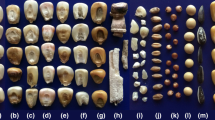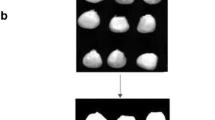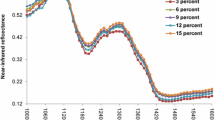Abstract
In order to quickly and non-destructively detect imperfect maize kernels, and to effectively enhance the efficiency of maize quality detection during collection and storage, identification models for imperfect maize kernels were constructed by using hyperspectral imaging (HSI) combined with machine learning techniques. Hyperspectral images of maize kernels in the range of 380–1000 nm were collected, and 10 spectral characteristic wavelengths (variables) were selected by using variable combination cluster analysis (VCPA). For grayscale images corresponding to these characteristic wavelengths, 3 texture features were extracted by using Tamura algorithm. Additionally, 3 color features and 4 morphological features were extracted through color moment analysis and regional geometry calculation, respectively. Based on the data of spectral features, image features and fusion features (spectral and image features), partial least squares regression (PLSR) and extreme learning machine (ELM) algorithms were respectively used to establish identification models for imperfect maize kernels. The results demonstrated that the overall average recognition accuracy of the ELM models was 91.60%, slightly surpassing the 91.29% achieved by the PLSR models. Notably, the ELM model based on the fusion features exhibited the highest recognition accuracy for heat-damaged kernels, achieving an accuracy rate of 97.22% in the test set. Therefore, the classification models established in this study proved to be feasible for the rapid and accurate identification of imperfect maize kernels. This can provide valuable technical support for the research and the development of non-destructive, rapid inspection equipment for imperfect kernels, as well as online batch detection.








Similar content being viewed by others
Data Availability
The data can be used with the author’s authorisation.
References
B. Wang, J. Sun, L. Xia, J. Liu, Z. Wang, P. Li, X. Sun, The applications of hyperspectral imaging technology for agricultural products quality analysis: a review. Food Rev. Int. 39(2), 1043–1062 (2021)
T. Singh, N.M. Garg, S.R.S. Iyengar, V. Singh, Near-infrared hyperspectral imaging for determination of protein content in barley samples using convolutional neural network. J. Food Meas. Charact. (2023). https://doi.org/10.1007/s11694-023-01892-x
P. Herzig, A. Backhaus, U. Seiffert, N. von Wirén, K. Pillen, A. Maurer, Genetic dissection of grain elements predicted by hyperspectral imaging associated with yield-related traits in a wild barley NAM population. Plant Sci. 285, 151–164 (2019)
J. Tschannerl, J. Ren, F. Jack, J. Krause, H. Zhao, W. Huang, S. Marshall, Potential of UV and SWIR hyperspectral imaging for determination of levels of phenolic flavour compounds in peated barley malt. Food Chem. 270, 105–112 (2019)
C. Singh, D. Jayas, J. Paliwal, N. White, Detection of sprouted and midge-damaged wheat kernels using near-infrared hyperspectral imaging. Cereal Chem. 86, 256–260 (2009)
J.G.A. Barbedo, E.M. Guarienti, C.S. Tibola, Detection of sprout damage in wheat kernels using NIR hyperspectral imaging. Biosyst. Eng. 175, 124–132 (2018)
N. Caporaso, M.B. Whitworth, I.D. Fisk, Protein content prediction in single wheat kernels using hyperspectral imaging. Food Chem. 240, 32–42 (2018)
S. Srivastava, H.N. Mishra, Detection of insect damaged rice grains using visible and near infrared hyperspectral imaging technique. Chemometr. Intell. Lab. Syst. 221, 104489 (2022)
Z. Zhang, X. Yin, C.J.A.M. Ma, Development of simplified models for the nondestructive testing of rice with husk starch content using hyperspectral imaging technology. Anal. Methods 11(46), 5910–5918 (2019)
Z. Liu, J. Jiang, M. Li, D. Yuan, C. Nie, Y. Sun, P. Zheng, Identification of moldy peanuts under different varieties and moisture content using hyperspectral imaging and data augmentation technologies. Foods 11(8), 1156 (2022)
S. Zou, Y.C. Tseng, A. Zare, D.L. Rowland, B.L. Tillman, S.C. Yoon, Peanut maturity classification using hyperspectral imagery. Biosyst. Eng. 188, 165–177 (2019)
P. Mishra, A. Herrero-Langreo, P. Barreiro, J.M. Roger, B. Diezma, N. Gorretta, L. Lleó, Detection and quantification of peanut traces in wheat flour by near infrared hyperspectral imaging spectroscopy using principal-component analysis. J Near Infrared Spec 23(1), 15–22 (2015)
H. Zhu, L. Yang, Z. Han, Quantitative aflatoxin B1 detection and mining key wavelengths based on deep learning and hyperspectral imaging in subpixel level. Comput. Electron. Agric. 206, 107561 (2023)
P. Xu, W. Sun, K. Xu, Y. Zhang, Q. Tan, Y. Qing, R. Yang, Identification of defective maize seeds using hyperspectral imaging combined with deep learning. Foods 12, 144 (2022)
F. Alimohammadi, M. Rasekh, A.H. Afkari-Sayyah, Y. Abbaspour-Gilandeh, H. Karami, V. Rasooli Sharabiani, D. Kwaśniewski, Hyperspectral imaging coupled with multivariate analysis and artificial intelligence to the classification of maize kernels. Int Agrophys 36, 83–91 (2022)
X. Chen, Y. Xun, W. Li, J. Zhang, Combining discriminant analysis and neural networks for corn variety identification. Comput. Electron. Agric. 71, S48–S53 (2010)
D. Yang, J. Jiang, Y. Jie, Q. Li, T. Shi, Detection of the moldy status of the stored maize kernels using hyperspectral imaging and deep learning algorithms. Int. J. Food Prop. 25, 170–186 (2022)
F. Tao, H. Yao, Z. Hruska, K. Rajasekaran, J. Qin, M. Kim, Use of line-scan Raman hyperspectral imaging to identify corn kernels infected with Aspergillus flavus. J. Cereal Sci. 102, 103364 (2021)
Z. Kang, T. Huang, S. Zeng, H. Li, L. Dong, C. Zhang, A method for detection of corn kernel mildew based on co-clustering algorithm with hyperspectral image technology. Sensors 22, 5333 (2022)
F. Tao, H. Yao, Z. Hruska, R. Kincaid, K. Rajasekaran, Near-infrared hyperspectral imaging for evaluation of aflatoxin contamination in corn kernels. Biosyst. Eng. 221, 181–194 (2022)
W. Wang, X. Ni, K.C. Lawrence, S.-C. Yoon, G.W. Heitschmidt, P. Feldner, Feasibility of detecting Aflatoxin B1 in single maize kernels using hyperspectral imaging. J. Food Eng. 166, 182–192 (2015)
D. Kimuli, W. Wang, K.C. Lawrence, S.C. Yoon, X. Ni, G.W. Heitschmidt, Utilisation of visible/near-infrared hyperspectral images to classify aflatoxin B1 contaminated maize kernels. Biosyst. Eng. 166, 150–160 (2018)
S.K. Chakraborty, N.K. Mahanti, S.M. Mansuri, Non-destructive classification and prediction of aflatoxin-B1 concentration in maize kernels using Vis–NIR (400–1000 nm) hyperspectral imaging. J. Food Sci. Technol. 58, 437–450 (2021)
L. Wang, D. Liu, H. Pu, D.W. Sun, W. Gao, Z. Xiong, Use of hyperspectral imaging to discriminate the variety and quality of rice. Food Anal. Methods 8(2), 515–523 (2015)
Y. Li, Y. Yin, H. Yu, Y. Yuan, Fast detection of water loss and hardness for cucumber using hyperspectral imaging technology. J. Food Meas. Charact. 16(1), 76–84 (2022)
D. Yang, A.X. Lu, J.H. Wang, Quantification and visualization of total volatile basic nitrogen content of cooked beef by hyperspectral imaging technique. Mod. Food Sci. Technol. 33(9), 257–264 (2017)
Y.H. Yun, W.T. Wang, B.C. Deng, G.B. Lai, X.B. Liu, D.B. Ren, Q.S. Xu, Using variable combination population analysis for variable selection in multivariate calibration. Anal. Chim. Acta 862, 14–23 (2015)
H. Tamura, S. Mori, T. Yamawaki, IEEE transactions on textural features corresponding to visual perception 8, 460–473 (1978)
M.A. Stricker, M. Orengo, Similarity of color images. Proc. SPIE Int. Soc. Opt. Eng. 2420, 381–392 (1970)
H.E. Tahir, A.A. Mariod, S.B.H. Hashim, M. Arslan, G.K. Mahunu, H. Xiaowei, L. Zhihua, I.I.H. Abdalla, Z. Xiaobo, Classification of Black Mahlab seeds (Monechma ciliatum) using GC–MS and FT-NIR and simultaneous prediction of their major volatile compounds using chemometrics. Food Chem. 408, 134948 (2023)
S. Sharma, K.C. Sumesh, P. Sirisomboon, Rapid ripening stage classification and dry matter prediction of durian pulp using a pushbroom near infrared hyperspectral imaging system. Measurement 189, 110464 (2022)
R. Brendel, S. Schwolow, S. Rohn, P. Weller, Comparison of PLSR, MCR-ALS and Kernel-PLSR for the quantification of allergenic fragrance compounds in complex cosmetic products based on nonlinear 2D GC-IMS data. Chemometr. Intell. Lab. Syst. 205, 104128 (2020)
G. Huang, G.B. Huang, S. Song, K. You, Trends in extreme learning machines: a review. Neural Netw. 61, 32–48 (2015)
G.B. Huang, Q.Y. Zhu, C.K. Siew, Extreme learning machine: theory and applications. Neurocomputing 70(1), 489–501 (2006)
Funding
Funding was provided by Foundation of Liaoning Province Education Administration (Grant No. LJKMZ20220610).
Author information
Authors and Affiliations
Corresponding author
Additional information
Publisher's Note
Springer Nature remains neutral with regard to jurisdictional claims in published maps and institutional affiliations.
Rights and permissions
Springer Nature or its licensor (e.g. a society or other partner) holds exclusive rights to this article under a publishing agreement with the author(s) or other rightsholder(s); author self-archiving of the accepted manuscript version of this article is solely governed by the terms of such publishing agreement and applicable law.
About this article
Cite this article
Song, K., Zhang, Y., Shi, T. et al. Rapid detection of imperfect maize kernels based on spectral and image features fusion. Food Measure 18, 3277–3286 (2024). https://doi.org/10.1007/s11694-024-02402-3
Received:
Accepted:
Published:
Issue Date:
DOI: https://doi.org/10.1007/s11694-024-02402-3




